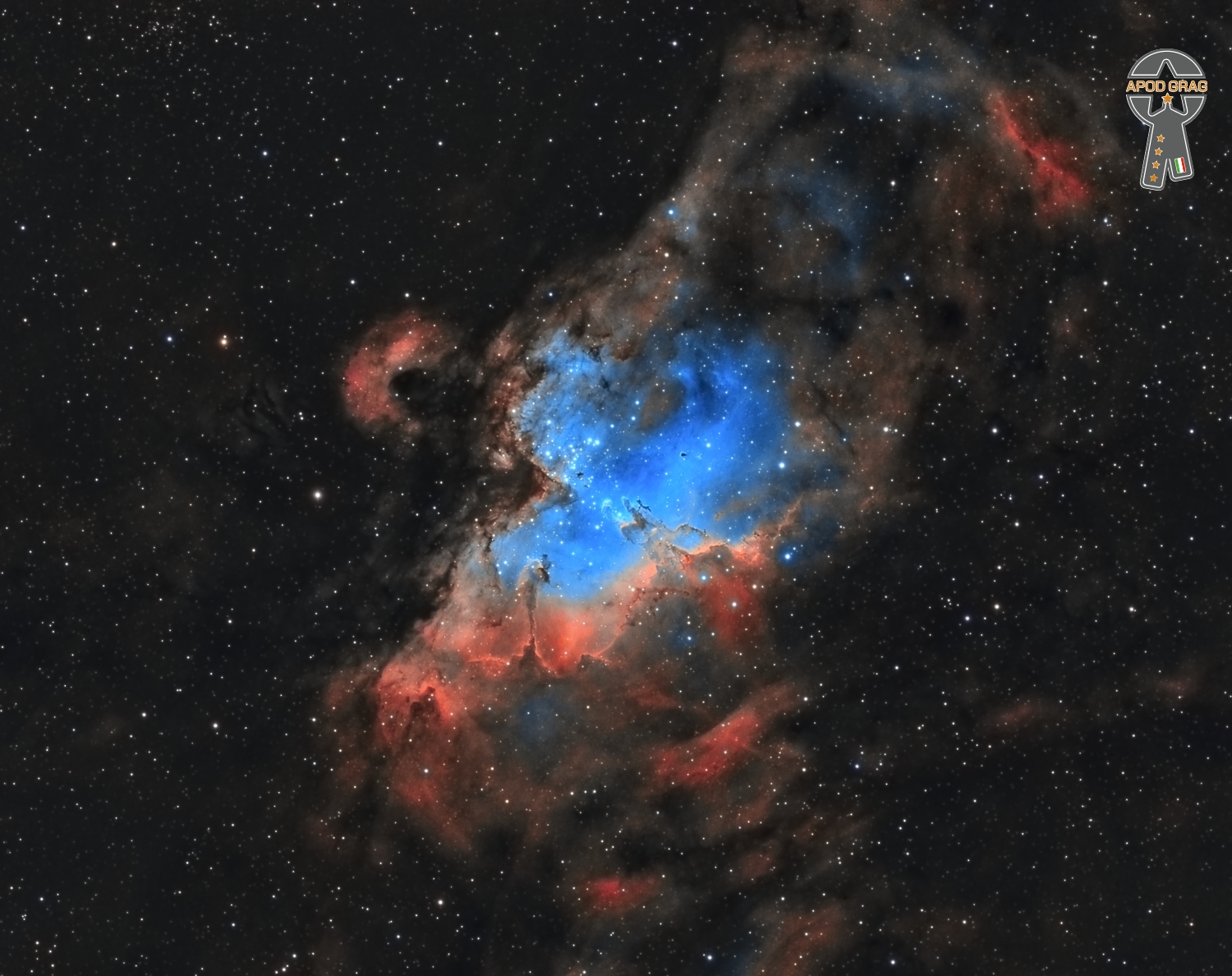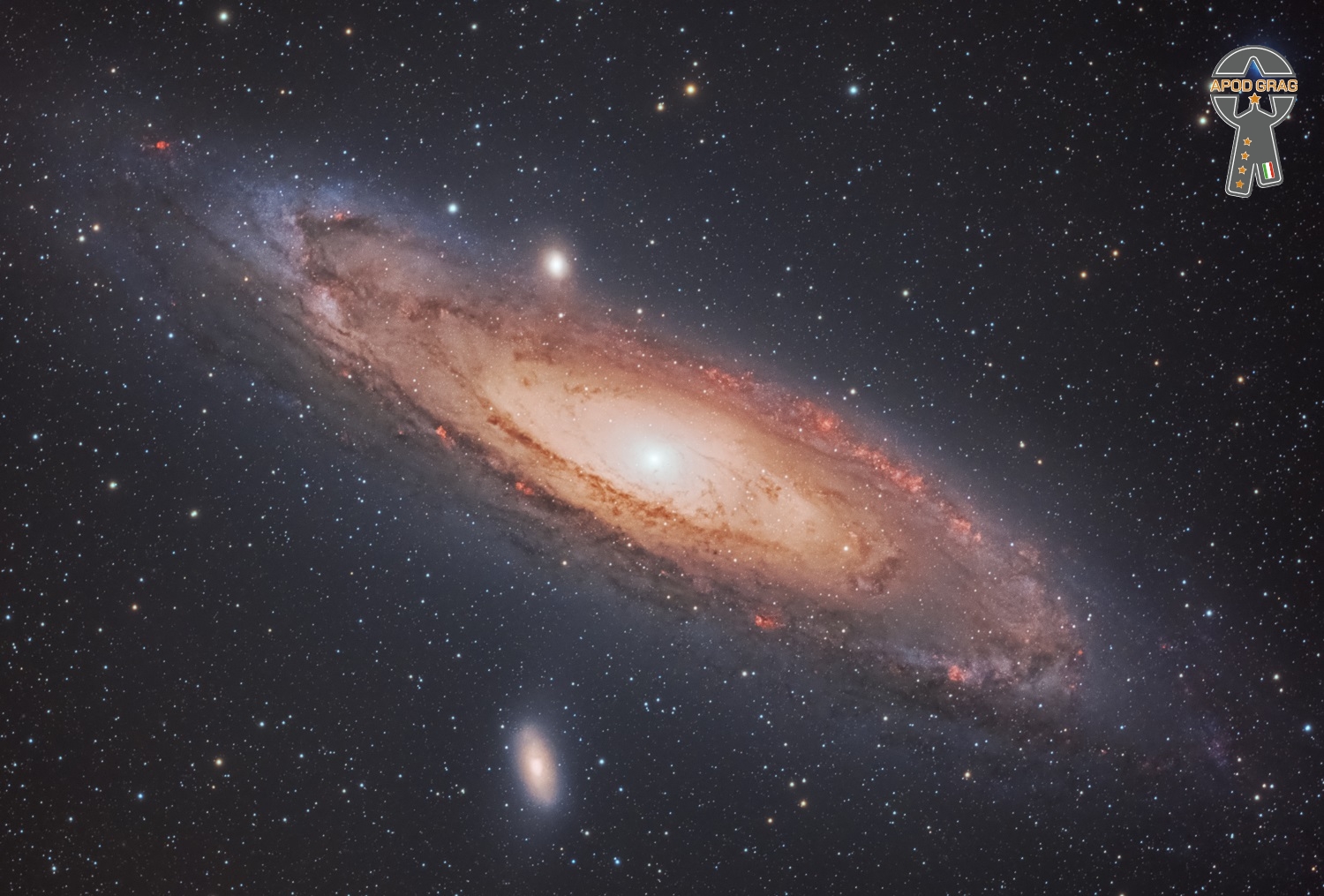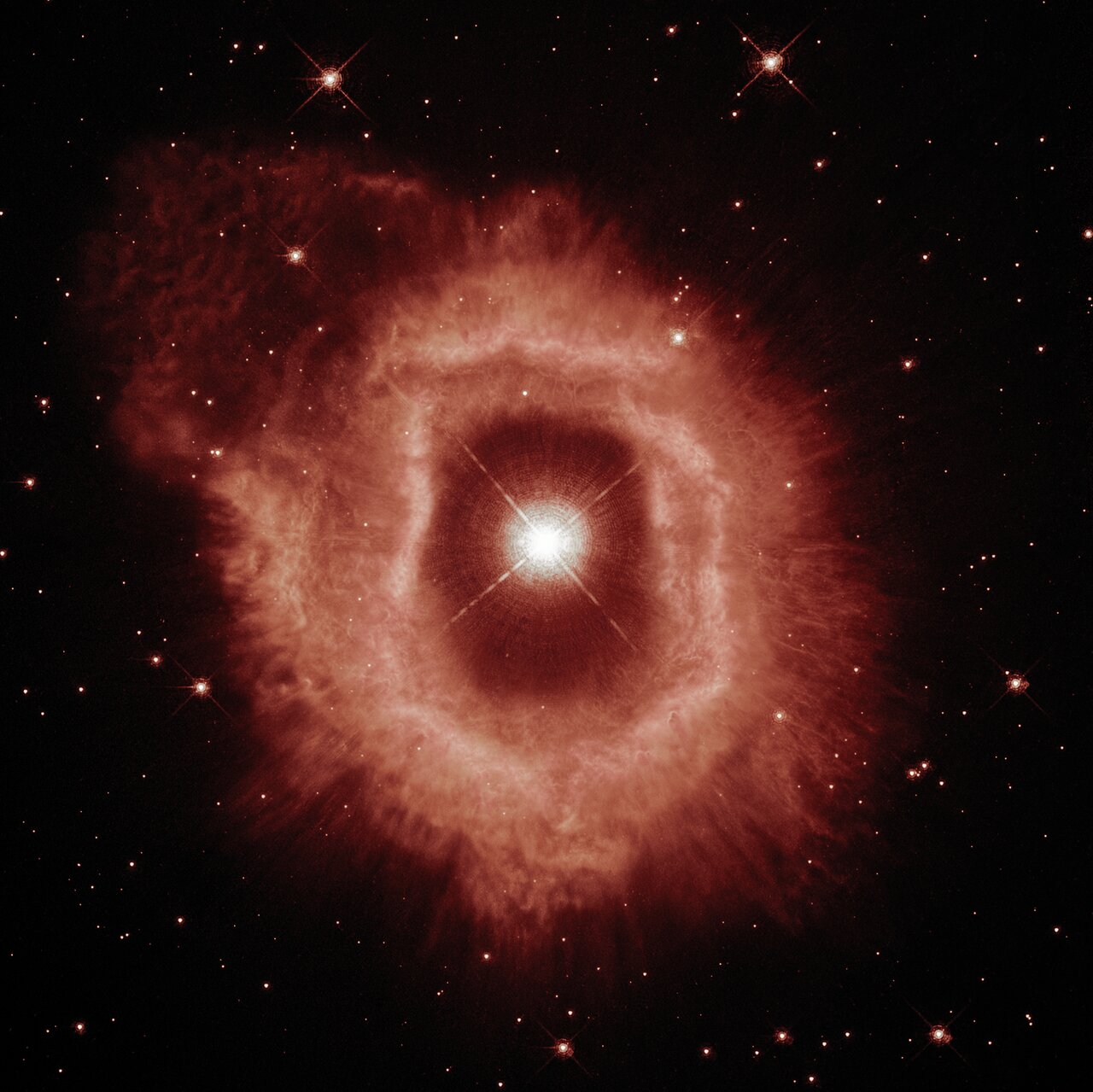Blog
The Eagle Nebula (catalogued as Messier 16 or M16, and as NGC 6611, and also known as the Star Queen Nebula and The Spire) is a young open cluster of stars in the constellation Serpens, discovered by Jean-Philippe de Cheseaux in 1745–46. Both the “Eagle” and the “Star Queen” refer to visual impressions of the dark silhouette near the center of the nebula, an area made famous as the “Pillars of Creation” imaged by the Hubble Space Telescope. The nebula contains several active star-forming gas and dust regions, including the aforementioned Pillars of Creation. The Eagle Nebula lies in the Sagittarius Arm of the Milky Way.
Julian Edwin “Cannonball” Adderley (September 15, 1928 – August 8, 1975) was an American jazz alto saxophonist of the hard bop era of the 1950s and 1960s.
Adderley is perhaps best remembered for the 1966 soul jazz single “Mercy, Mercy, Mercy“, which was written for him by his keyboardist Joe Zawinuland became a major crossover hit on the pop charts. A cover version by the Buckinghams also reached #5 on the charts. Adderley worked with Miles Davis, first as a member of the Davis sextet, appearing on the seminal records Milestones (1958) and Kind of Blue (1959), and then on his own 1958 album Somethin’ Else. He was the elder brother of jazz trumpeter Nat Adderley, who was a longtime member of his band.
Originally from Tampa, Florida, his nickname derived from “cannibal”, a title imposed on him by high-school colleagues as a tribute to his voracious appetite. Cannonball moved to Tallahassee when his parents obtained teaching positions at Florida A&M University. Both Cannonball and brother Nat played with Ray Charles when Charles lived in Tallahassee during the early 1940s. Adderley moved to Broward County, Florida, in 1948 after finishing his music studies at Florida A&M and became the band director at Dillard High School in Fort Lauderdale, a position which he held until 1950.
Cannonball left Southeast Florida and moved to New York in 1955. One of his known addresses in New York was in the neighborhood of Corona, Queens. He left Florida originally to seek graduate studies at New York conservatories, but one night in 1955 he brought his saxophone with him to the Café Bohemia. Cannonball was asked to sit in with Oscar Pettiford in place of his band’s regular saxophonist, who was late for the gig. The “buzz” on the New York jazz scene after Adderley’s performance announced him as the heir to the mantle of Charlie Parker.
more...Albert Aloysius Casey (September 15, 1915 – September 11, 2005), known professionally as Al Casey, was an American jazz guitarist who was a member of Fats Waller‘s band during the 1930s and early 1940s.
Casey was born in Louisville, Kentucky. He attended DeWitt Clinton High School in New York City and studied guitar.
He was a child prodigy who first played violin, then switched to ukulele. He began playing guitar in 1930 and met Fats Waller in 1933. The following year, at the age of eighteen, he became a member of Waller’s band, making many recordings with the band, and he is known for having played the solo in “Buck Jumpin'”. After Waller’s death in 1943, he led his own trio. For two consecutive years in the 1940s, he was voted best guitarist in Esquiremagazine.
more...Arvell Shaw (September 15, 1923 – December 5, 2002) was an American jazz double-bassist, best known for his work with Louis Armstrong.
He was born in St. Louis, Missouri, United States. Shaw learned to play tuba in high school, but switched to bass soon after. In 1942 he worked with Fate Marable on riverboats traveling on the Mississippi River, then served in the Navy from 1942 to 1945. After his discharge he played with Armstrong in his last big band, from 1945 to 1947. Shaw and Sid Catlett then joined the Louis Armstrong All-Stars until 1950, when Shaw broke off to study music. He returned to play with Armstrong from 1952 to 1956, and performed in the 1956 musical, High Society.
more...Roy Claxton Acuff (September 15, 1903 – November 23, 1992) was an American country music singer, fiddler, promoter, and freemason. Known as the “King of Country Music”, Acuff is often credited with moving the genre from its early string band and “hoedown” format to the singer-based format that helped make it internationally successful. In 1952, Hank Williams told Ralph Gleason, “He’s the biggest singer this music ever knew. You booked him and you didn’t worry about crowds. For drawing power in the South, it was Roy Acuff, then God.”
Acuff began his music career in the 1930s and gained regional fame as the singer and fiddler for his group, the Smoky Mountain Boys. He joined the Grand Ole Opry in 1938, and although his popularity as a musician waned in the late 1940s, he remained one of the Opry’s key figures and promoters for nearly four decades. In 1942, Acuff and Fred Rose founded Acuff-Rose Music, the first major Nashville-based country music publishing company, which signed such artists as Hank Williams, Roy Orbison, and the Everly Brothers. In 1962, Acuff became the first living inductee into the Country Music Hall of Fame.
Acuff was born on September 15, 1903 in Maynardville, Tennessee, to Ida (née Carr) and Simon E. Neill Acuff, the third of their five children. Roy Acuff is of Scottish ancestry, and his ancestors came to North America during the colonial era, settling in the mountains of Virginia and the Carolinas. The Acuffs were a fairly prominent family in Union County. Roy’s paternal grandfather, Coram Acuff, had been a Tennessee state senator, and his maternal grandfather was a local physician. Roy’s father was an accomplished fiddler and a Baptist preacher, his mother was proficient on the piano, and during Roy’s early years the Acuff house was a popular place for local gatherings. At such gatherings, Roy would often amuse people by balancing farm tools on his chin. He also learned to play the harmonica and jaw harp at an early age.
more...https://www.youtube.com/watch?v=xXssKGJLdf8&list=PLEB3LPVcGcWbHKyo-uy8CkVvebHEsluVK&index=53
more...The Andromeda Galaxy, also known as Messier 31, M31, or NGC 224 and originally the Andromeda Nebula, is a barred spiral galaxy approximately 2.5 million light-years from Earth and the nearest large galaxy to the Milky Way.
Setup :
– Skywatcher EQM 35 mount driven via EQMOD in NINA
– TS 71 SDQ scope (focal length 450mm)
– ZWO Asi 2600 MC camera (cooled to -10°C, gain 100 and offset 50)
– Siril + PixInsight + Photoshop
Exifs :
– 60 x 300s in RGB with IDAS P3 anti-PIL filter
– 30 x 600s with L-extrem filter
– 20 DOF
– Sky Bortle 5 (Avril, Grand Est, France)

Frederick Dewey Smith (September 14, 1948 – November 4, 1994), known professionally as Fred “Sonic” Smith, was an American guitarist, best known as a member of the influential and political Detroit rock band MC5.At age 31, he married and raised a family with poet and fellow rock musician Patti Smith. The couple collaborated musically, and raised two children together.
Smith was a guitarist with the MC5 and later went on to form Sonic’s Rendezvous Band, which released one single, “City Slang”, during Smith’s lifetime. In 1988 he collaborated with Patti Smithon her album Dream of Life.
In 2018, Smith was inducted into the West Virginia Music Hall of Fame alongside Hasil Adkins and Ann Magnuson. A resident of St. Clair Shores, Michigan (a Detroit suburb), Fred Smith died in Detroit in 1994. He had been in poor health for years and succumbed to heart failure.
more...Oliver Lake (born September 14, 1942) is an American jazz saxophonist, flutist, composer, poet, and visual artist. He is known mainly for alto saxophone, but he also performs on soprano and flute. During the 1960s, Lake worked with the Black Artists Group in St. Louis. In 1977, he founded the World Saxophone Quartet with David Murray, Julius Hemphill, and Hamiet Bluiett. He has worked in the group Trio 3 with Reggie Workman and Andrew Cyrille. He has appeared on more than 80 albums as a bandleader, co-leader, and side musician. He is the father of drummer Gene Lake. Lake has been a resident of Montclair, New Jersey.
more...Joseph Jarman (September 14, 1937 – January 9, 2019) was an American jazz musician, composer, poet, and Shinshu Buddhist priest. He was one of the first members of the Association for the Advancement of Creative Musicians and a member of the Art Ensemble of Chicago.
He was born in Pine Bluff, Arkansas, United States. Jarman grew up in Chicago, Illinois. At DuSable High School, he studied drums with Walter Dyett, switching to saxophone and clarinet when he joined the United States Army after graduation. During his time there, he was part of the 11th Airborne Division Band for a year.
more...Israel López Valdés (September 14, 1918 – March 22, 2008), better known as Cachao (/kəˈtʃaʊ/ kə-CHOW), was a Cuban double bassist and composer. Cachao is widely known as the co-creator of the mambo and a master of the descarga (improvised jam sessions). Throughout his career he also performed and recorded in a variety of music styles ranging from classical music to salsa. An exile in the United States since the 1960s, he only achieved international fame following a career revival in the 1990s.
Born into a family of musicians in Havana, Cachao and his older brother Orestes were the driving force behind one of Cuba’s most prolific charangas, Arcaño y sus Maravillas. As members of the Maravillas, Cachao and Orestes pioneered a new form of ballroom music derived from the danzón, the danzón-mambo, which subsequently developed into an international genre, mambo. In the 1950s, Cachao became famous for popularizing improvised jam sessions known as descargas. He emigrated to Spain in 1962, and moved to the United States in 1963, starting a career as a session and live musician for a variety of bands in New York during the rise of boogaloo, and later, salsa.
In the 1970s, Cachao fell into obscurity after moving to Las Vegas and later Miami, releasing albums sporadically as a leader. In the 1990s, he was re-discovered by actor Andy García, who brought him back to the forefront of the Latin music scene with the release of a documentary and several albums. Before his death in 2008, Cachao had earned a star on the Hollywood Walk of Fame and several Grammy Awards. He is ranked number 24 on Bass Player magazine’s list of “The 100 Greatest Bass Players of All Time”. Cachao was born on September 14, 1918, in Belén, a neighbourhood in Old Havana, into a family of musicians, many of them bassists—around 40 or more in his extended family. He was born and raised in the same house in which José Martí was born. His nickname and stage name Cachao was given to him by his grandfather Aurelio López, from the Spanish word “cachondeo” (banter).
This Picture of the Week showcases new views of the dual nature of the star AG Carinae, which was the target of the NASA/ESA Hubble Space Telescope’s 31st anniversary image in April 2020. This new perspective was developed thanks to Hubble’s observations of the star in 2020 and 2014, along with others captured by the telescope’s WFPC2 instrument in 1994. You can compare these two new versions of AG Carinae by using the slider tool on the image above.
The first image showcases the details of the ionised hydrogen and ionised nitrogen emissions from the nebula (seen here in red). In the second image, the blue demonstrates the contrasting appearance of the distribution of the dust that shines of reflected stellar light. Astronomers believe that the dust bubbles and filaments formed within and were shaped by powerful stellar wind .
This giant star is waging a tug-of-war between gravity and radiation to avoid self-destruction. The star is surrounded by an expanding shell of gas and dust — a nebula — that is shaped by the powerful winds emanating from the star. The nebula is about five light-years wide, equal to the distance from here to our nearest star, Alpha Centauri.

Tony Russell “Charles” Brown (September 13, 1922 – January 21, 1999) was an American blues singer and pianist whose soft-toned, slow-paced blues-club style influenced blues performance in the 1940s and 1950s. Between 1949 and 1952, Brown had seven Top 10 hits in the U.S. BillboardR&B chart. His best-selling recordings included “Driftin’ Blues” and “Merry Christmas Baby“.
Brown was born in Texas City, Texas. As a child he loved music and received classical music training on the piano. He graduated from Central High School in Galveston, Texas, in 1939 and Prairie View A&M College in 1942 with a degree in chemistry. He then became a chemistry teacher at George Washington Carver High School in Baytown, Texas, a mustard gas worker at the Pine Bluff Arsenal at Pine Bluff, Arkansas, and an apprentice electrician at a shipyard in Richmond, California, before settling in Los Angeles in 1943.
more...William Smith Monroe (/mənˈroʊ/; September 13, 1911 – September 9, 1996) was an American mandolinist, singer, and songwriter, who created the bluegrass music genre. Because of this, he is often called the “Father of Bluegrass“.
The genre takes its name from his band, the Blue Grass Boys, who named their group for the bluegrass of Monroe’s home state of Kentucky. Monroe’s performing career spanned 69 years as a singer, instrumentalist, composer and bandleader. Monroe was born on his family’s farm near Rosine, Kentucky, the youngest of eight children of James Buchanan “Buck” and Malissa (Vandiver) Monroe. His mother and her brother, Pendleton “Pen” Vandiver, were both musically talented, and Monroe and his family grew up playing and singing at home. Bill was of Scottish and English heritage. Because his older brothers Birch and Charlie already played the fiddle and guitar, Bill was resigned to playing the less desirable mandolin. He recalled that his brothers insisted that he remove four of the mandolin’s eight strings so he would not play too loudly.
more...Leon Brown “Chu” Berry (September 13, 1908 – October 30, 1941) was an American jazz tenor saxophonist during the 1930s.
According to music critic Gary Giddins, musicians called him “Chu” either because he chewed on the mouthpiece of his saxophone or because he had a Fu Manchu mustache.
Berry was born in Wheeling, West Virginia. He graduated from Lincoln High School, in Wheeling, then attended West Virginia State College for three years. His sister Ann played piano. Berry became interested in music at an early age, playing alto saxophone, at first with local bands. He was inspired to take up the tenor saxophone after hearing Coleman Hawkins on tour.
Most of Berry’s career was spent with swing bands: Sammy Stewart, 1929–1930, with whom he switched to tenor sax, Benny Carter, 1932–1933, Teddy Hill, 1933–1935, Fletcher Henderson, 1935–1937, Cab Calloway, his best-known affiliation, from 1937 to 1941. Berry is credited with turning Calloway’s band into a legitimate jazz orchestra over the four years of his membership. Throughout his brief career, Berry was in demand as a sideman for recording sessions under the names of various other jazz artists, including Spike Hughes (1933), Bessie Smith (1933), The Chocolate Dandies (1933), Mildred Bailey (1935–1938), Teddy Wilson (1935–1938), Billie Holiday (1938–1939), Wingy Manone (1938–1939) and Lionel Hampton (1939).
more...Arnold Schoenberg or Schönberg ; 13 September 1874 – 13 July 1951) was an Austrian-born composer, music theorist, teacher, writer, and painter. He is widely considered one of the most influential composers of the 20th century. He was associated with the expressionist movement in German poetry and art, and leader of the Second Viennese School. As a Jewish composer, Schoenberg was targeted by the Nazi Party, which labeled his works as degenerate music and forbade them from being published. He emigrated to the United States in 1933, becoming an American citizen in 1941.
Schoenberg’s approach, bοth in terms of harmony and development, has shaped much of 20th-century musical thought. Many European and American composers from at least three generations have consciously extended his thinking, whereas others have passionately reacted against it.
Schoenberg was known early in his career for simultaneously extending the traditionally opposed German Romantic styles of Brahms and Wagner. Later, his name would come to personify innovations in atonality (although Schoenberg himself detested that term) that would become the most polemical feature of 20th-century classical music. In the 1920s, Schoenberg developed the twelve-tone technique, an influential compositional method of manipulating an ordered series of all twelve notes in the chromatic scale. He also coined the term developing variation and was the first modern composer to embrace ways of developing motifs without resorting to the dominance of a centralized melodic idea.
Schoenberg was also an influential teacher of composition; his students included Alban Berg, Anton Webern, Hanns Eisler, Egon Wellesz, Nikos Skalkottas, Stefania Turkewich, and later John Cage, Lou Harrison, Earl Kim, Robert Gerhard, Leon Kirchner, Dika Newlin, Oscar Levant, and other prominent musicians. Many of Schoenberg’s practices, including the formalization of compositional method and his habit of openly inviting audiences to think analytically, are echoed in avant-garde musical thought throughout the 20th century. His often polemical views of music history and aesthetics were crucial to many significant 20th-century musicologists and critics, including Theodor W. Adorno, Charles Rosen, and Carl Dahlhaus, as well as the pianists Artur Schnabel, Rudolf Serkin, Eduard Steuermann, and Glenn Gould.
Schoenberg’s archival legacy is collected at the Arnold Schönberg Center in Vienna.
more...More Posts
- Booker Little
- World Music Cumar Dhuule
- Daily Roots Dennis Brown
- Alien Spaceships Circling Earth
- Challenge to Change
- Cosmo NGC 4945
- Jorge López Ruiz
- Alberta Hunter
- Gilbert Scott-Heron
- Duke Jordan
- World Music Faysal Cumar Mushteeg Ahun
- Daily Roots Tommy McCook Supersonics
- Ahmed Yusuf & Somali Blues Performance 4-6-2025
- Don’t Lose Your Head
- Protect Our Children
- Introspection
- Canadian Solidarity
- Cosmo NGC 4941
- Joseph Haydn
- Johann Sebastian Bach